The research paper titled "Template-etched sodium alginate hydrogel as the sublayer to improve the FO performance with double barriers for high metal ion rejection" is authored by Master student Wei Huang as the first author and Associate Professor Changkun Liu as the corresponding author. The affiliations of both the first author and the corresponding author are Shenzhen University. This paper was published in Chemical Engineering Journal, which has an impact factor of 16.744 (at the accepted/publication date) and is listed as Tier 1 journal as categorized by the Chinese Academy of Sciences.
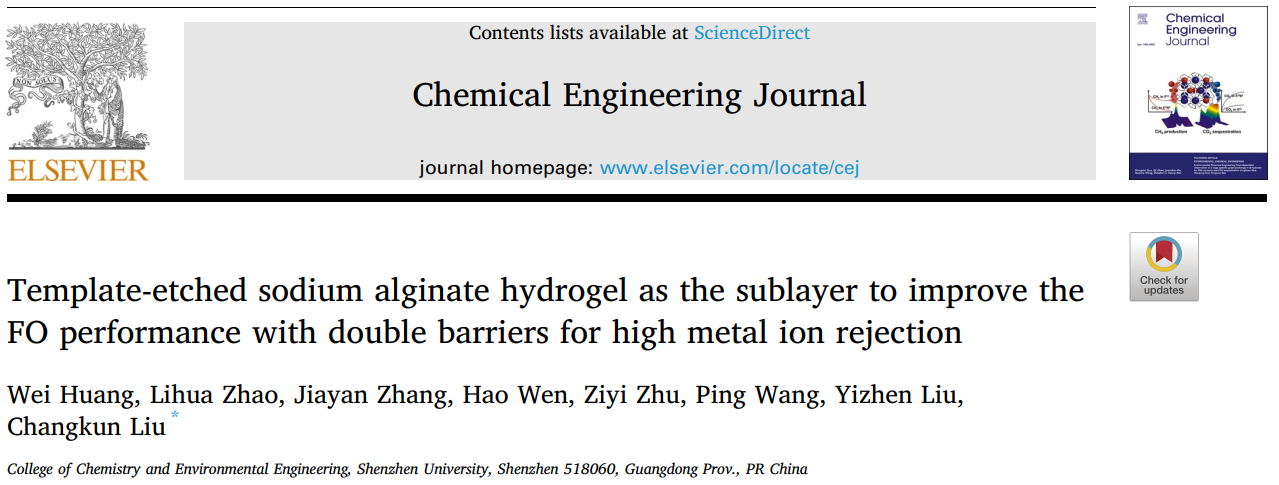
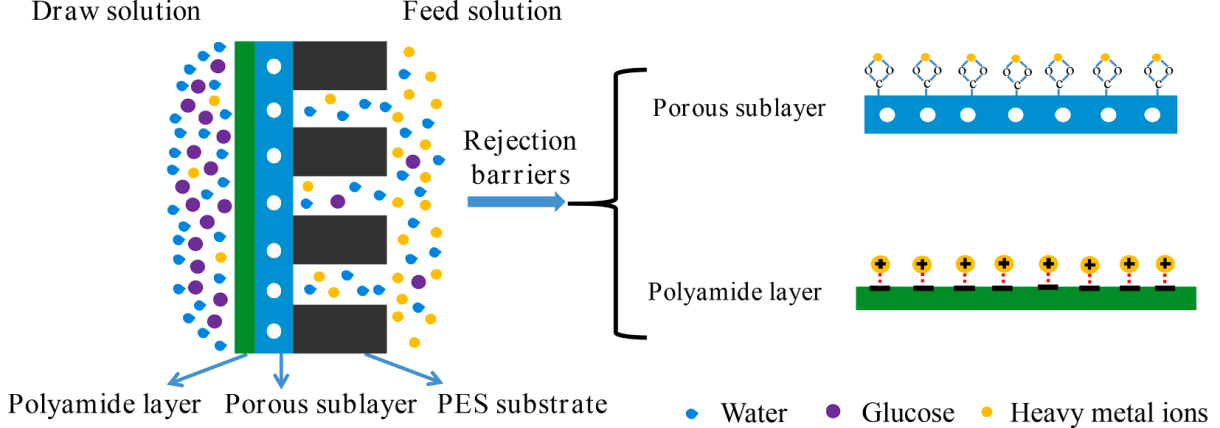
In this research, preparation of a forward osmosis membrane that can effectively reject heavy metals in wastewater treatment would prove to be highly beneficial. Here, an innovative forward osmosis (FO) membrane with a “sandwich” structure (formed via the template method) was achieved for the first time through the fabrication of a porous hydrogel sublayer. A porous hydrogel matrix with excellent water retention capacity was formed through the crosslinking reaction of sodium alginate and calcium chloride in the presence of zinc oxide (ZnO) nanoparticles, followed by etching to remove the ZnO nanoparticles in the sublayer to produce the porous structure. The water flux of the modified membrane was quintuple compared with the that of the original membrane, with no reduction on the salt rejection performance. The surface polyamide layer and sublayer acted as double barriers and achieved a rejection rate of over 98% for heavy metal ions (Cd2+, Cu2+, Pb2+, Ni2+), when the glucose solution was used as the draw solution. The inclusion of the porous sublayer can provide deeper insights into the fabrication of high-performance FO membranes, and expand their applications.
Full-text link: https://doi.org/10.1016/j.cej.2020.127425
The research paper titled "Highly permeable forward osmosis membrane with selective layer “hooked” to a hydrophilic Cu-Alginate intermediate layer for efficient heavy metal rejection and sludge thickening" is authored by Master student Hui Wen as the first author and Associate Professor Changkun Liu as the corresponding author. The affiliations of both the first author and the corresponding author are Shenzhen University. This paper was published in Journal of Membrane Science, which has an impact factor of 9.5 (at the accepted/publication date) and is listed as Tier 1 journal as categorized by the Chinese Academy of Sciences.
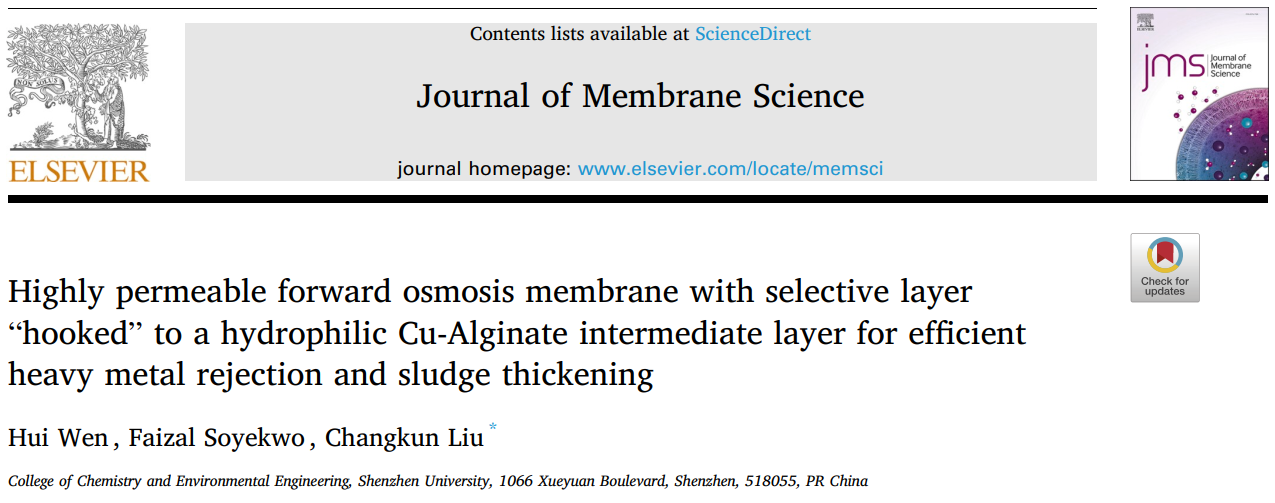
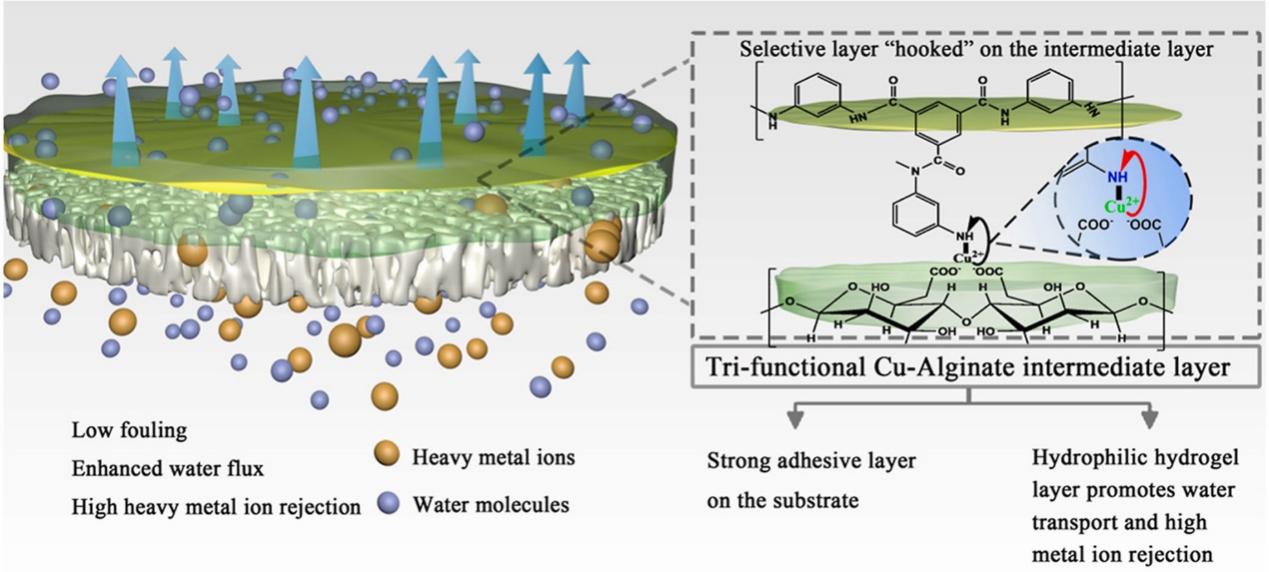
Development of stable membranes with high permeability and high separation performance are highly desirable but challenging for polyamide-based forward osmosis (FO) membranes. Herein, a novel FO membrane is prepared through the formation of polyamide (PA) selective layer on Cu-alginate hydrogel intermediate layer-modified polyethersulfone (PES) support. The formed dense, uniform, and crumbled PA selective layer is firmly “hooked” on the Cu-alginate intermediate layer due to the strong chelation crosslinking between the Cu2+ in the intermediate layer and –NH2 groups of MPD. Meanwhile, the hydrophilic tri-functional Cu-Alginate intermediate layer promotes the enhancement of the water flux and acted as an effective barrier for high heavy metal ions (Cd2+, Cu2+, Pb2+) with the rejection of more than 96% owing to the additional charge repulsion effect by the Cu2+ in the membrane matrix. The water flux of the resultant composite FO membrane (PES/Cu-SA/PA) was doubled that of the membrane without modification. Moreover, the membrane exhibited a steady water flux decline during a continuous 24 h sludge thickening process, as compared with the 10 h fast decline of the water flux of with the pristine FO membrane. This work underscores the progress of intermediate layer-assisted formation of the polyamide selective layer as a promising strategy for the design of FO membranes with good stability for the efficient removal of heavy metal ions as well as extended applications such as sludge thickening.
Full-text link: https://doi.org/10.1016/j.memsci.2021.120247
The research paper titled "Crumpled Globule-Heterotextured Polyamide Membrane Interlayered with Protein-Polyphenol Nanoaggregates for Enhanced Forward Osmosis Performance" is authored by Research Associate Faizal Soyekwo and Master student Hui Wen as the co-first author, and Associate Professor Changkun Liu as the corresponding author. The affiliations of both the first author and the corresponding author are Shenzhen University. This paper was published in ACS Applied Materials & Interfaces, which has an impact factor of 9.5 (at the accepted/publication date) and is listed as Tier 1 journal as categorized by the Chinese Academy of Sciences.

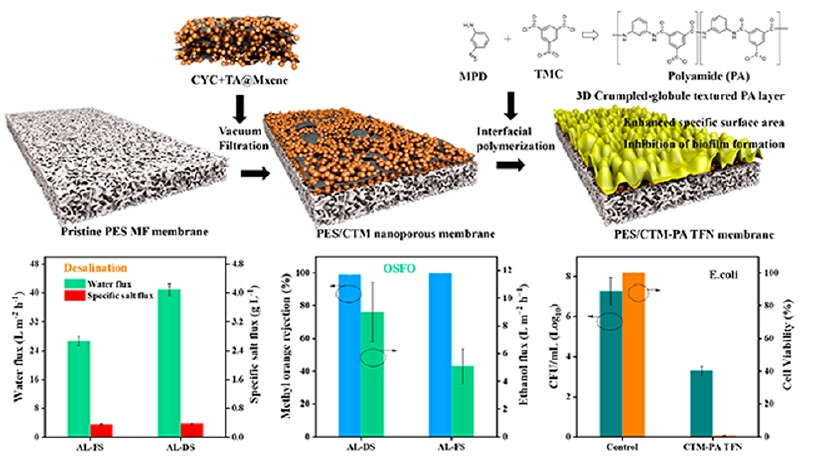
Surface modulation of polyamide structures and the development of nanochanneled membranes with excellent water transport properties are crucial for the separation performance enhancement of thin-film composite membranes. Here, we demonstrate the fabrication of a modular nanochannel-integrated polyamide network on a nanoporous interlayer membrane comprising Mxene-reinforced protein–polyphenol nanoaggregates. The research indicates that the confined growth of the polyamide matrix inside this hydrophilic sub-10 nm nanochannel nanoporous intermediate layer stiffened the interfacial channels, leading to the formation of a polyamide layer with a spatial distribution of a network of unique 3D crumpled globule-like nanostructures. The high specific surface area of such a morphology bestowed the membrane with increased filtration area while facilitating the nanofluidic transport of water molecules through the nanochanneled membrane structure, leading to enhanced water flux of up to 26.6 L m–2 h–1 (active layer facing the feed solution) and 41.0 L m–2 h–1 (active layer facing the draw solution) using 1.0 M NaCl as the draw solution. The membrane equally exhibited good treatment for organic solvent forward osmosis filtration and typical seawater desalination. Moreover, the hierarchical nanostructures induced antimicrobial activity by effectively reducing the biofilm formation of Gram-negative Escherichia coli bacteria. This work provides significant insights into the interfacial engineering and compatibility of the nanomaterials and the polymers in interlayer mixed-matrix membranes, which are environmentally sustainable and cost-effective for the fabrication of advanced forward osmosis membranes for water purification and osmotic energy applications.
Full-text link: https://doi.org/10.1021/acsami.2c05075
The research paper titled "Fouling-resistant ionic graft-polyamide nanofiltration membrane with improved permeance for lithium separation from MgCl2/LiCl mixtures" is authored by Research Associate Faizal Soyekwo as the first author, and Associate Professor Changkun Liu as the corresponding author. The affiliations of both the first author and the corresponding author are Shenzhen University. This paper was published in Journal of Membrane Science, which has an impact factor of 9.5 (at the accepted/publication date) and is listed as Tier 1 journal as categorized by the Chinese Academy of Sciences.
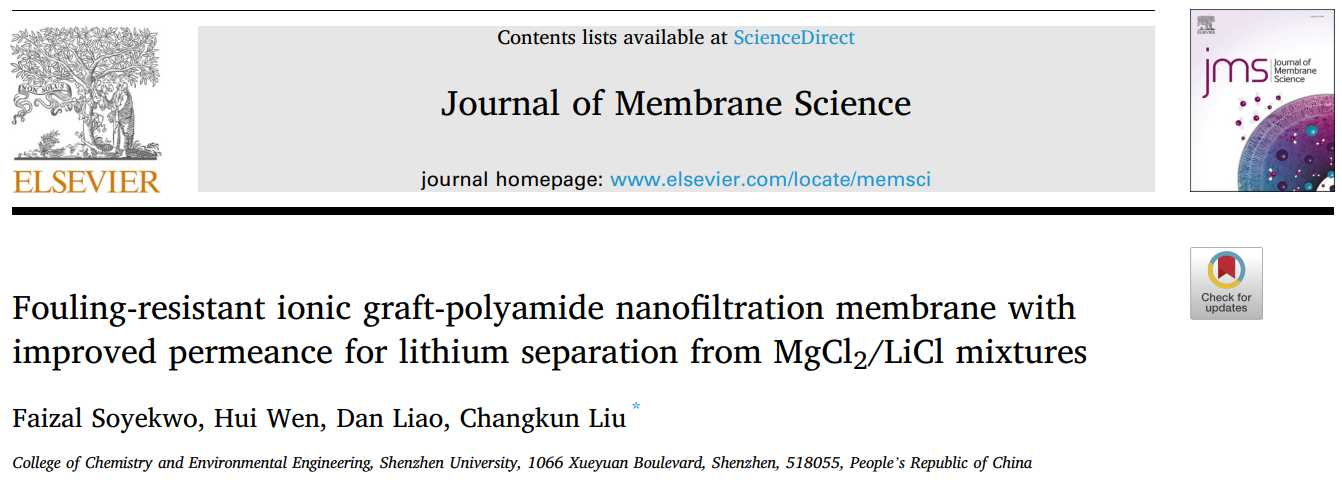

Selective recovery of lithium from Salt Lake brines using environmentally friendly technologies is increasingly demanded to overcome the shortage of lithium. However, satisfying high separation precision is challenging for most polymer nanofiltration membranes. Besides, bestowing high permeance together with improved membrane fouling remains a challenge for the widespread implementation of membrane processes. Herein, a new tri-quaternary ammonium-based ionic liquid (TQAIL) electrolyte monomer is synthesized and utilized for the surface modification of nascent polyamide active layer to fabricate IL-modified polyamide nanofiltration (NF) membrane for Mg2+/Li+ separation. Molecular dynamics simulations confirm that TQAIL modification creates nanoscale structural heterogeneity leading to enhanced surface hydrophilicity and reduces internal resistance through the membrane selective layer. The TQAIL membrane exhibits improved Li+/Mg2+ selectivity and improved water permeability of 26.11 L m-2 h−1 bar−1, which is fourfold that of unmodified membrane accompanied with a 100-h stable continuous nanofiltration. Moreover, themembrane displays good anti-biofouling behaviour with excellent antimicrobial properties. This study offers new insights into how surface functionalization using multication side chains can remarkably improve ion separations by molecularly tuning ion-membrane electrostatic interactions in polymeric membranes.
Full-text link: https://doi.org/10.1016/j.memsci.2022.120773
The research paper titled "Nanofiltration Membranes Modified with a Clustered Multiquaternary Ammonium-Based Ionic Liquid for Improved Magnesium/Lithium Separation" is authored by Research Associate Faizal Soyekwo as the first author, and Associate Professor Changkun Liu as the corresponding author. The affiliations of both the first author and the corresponding author are Shenzhen University. This paper was published in ACS Applied Materials & Interfaces, which has an impact factor of 9.5 (at the accepted/publication date) and is listed as Tier 1 journal as categorized by the Chinese Academy of Sciences.

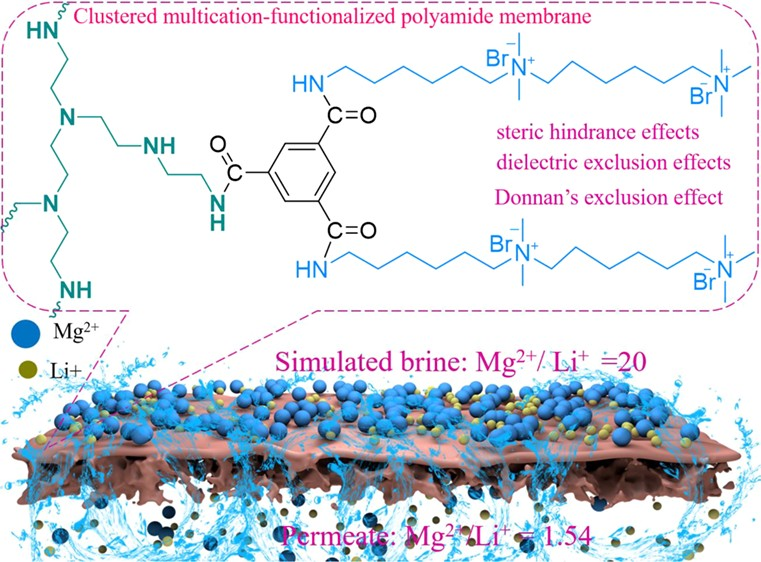
Lithium separation is of great significance to overcome the lithium supply shortage resulting from a heightened demand in the energy sector. The low selectivity of polymer nanofiltration membranes for lithium extraction from concentrated Mg/Li mixtures caused by miniaturized pore structures and weak and unstable positive surface charges limits their practical implementation. To address the surface charge strength and stability, a novel ionic liquid monomer, N1-(6-aminohexyl)-N1,N1,N6,N6,N6-pentamethylhexane-1,6-diaminium bromide (denoted as DABIL), is first synthesized and covalently anchored on a pristine polyamide thin-film composite (TFC) membrane via a secondary amidation reaction for improved selective lithium separation from Mg/Li mixtures. DABIL modification of the polyamide network contributes to increased surface hydrophilicity, an enlarged membrane pore structure, and reinforced Donnan exclusion effects. Molecular dynamics simulation confirmed that the difference of the interaction energies between water and the multication groups dominates the surface properties. The DABIL membrane exhibits sixfold enhancement of water permeability compared to the unmodified membrane and outperforms the recently reported state-of-the-art positively charged membranes. It presents an improved Li+/Mg2+ selectivity of 26.49, suggesting the membranes’ potential for lithium recovery. Moreover, the membrane shows efficient antibacterial activity for mitigating biofilm formation. We establish that functionalization of TFC membranes with ionic liquids containing multication side chains could be a promising approach to achieve improved and sustainable permselectivity for the recovery of critical metal resources.
Full-text link: https://doi.org/10.1021/acsami.2c03650
The research paper titled "Superhydrophobic-slip surface based heat and mass transfer mechanism in vacuum membrane distillation" is authored by post-doc researcher Jun Liu as the first author, and Associate Professor Changkun Liu as the corresponding author. The affiliations of both the first author and the corresponding author are Shenzhen University. This paper was published in Journal of Membrane Science, which has an impact factor of 9.23 (at the accepted/publication date) and is listed as Tier 1 journal as categorized by the Chinese Academy of Sciences.
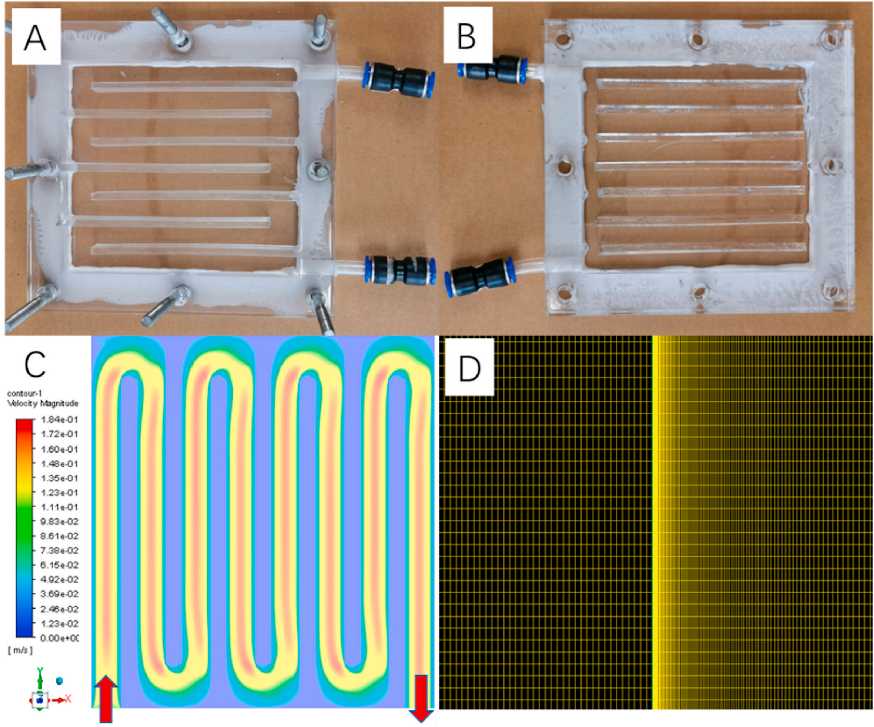
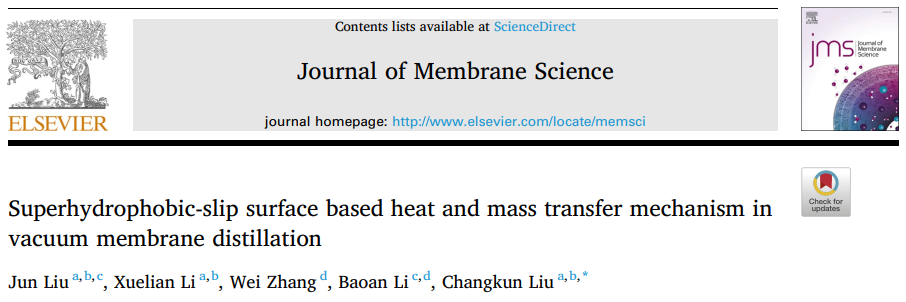
Superhydrophobic membrane is favorable for the membrane distillation technology in desalination applications although the theoretic reasons are still unsettled. In this study, some novel theories were first proposed to establish the bridges between the surface parameters (including water contact angle and surface roughness) and the heat and mass transfer process. Based on the hydrophobic PVDF membrane (with a water contact angle of 124°), a kind of superhydrophobic PVDF membrane with a water contact angle of 162° was prepared through the surface modification. Then both membranes were tested in the vacuum membrane distillation (VMD) process, and simulation models based on both kind of membranes were constructed to compare the membrane performances and the heat and mass transfer characteristics. The results show that the slip flow exists on the superhydrophobic surface, and the superhydrophobic membrane has higher permeate flux than the original PVDF membrane. The insight investigations show that the heat transfer resistance (HTR) of the VMD process is focused on the membrane layers, and the variation of water contact angle or roughness has little influence on the heat transfer coefficient of the membrane layers. However, when the water contact angle varies from 124° to 165°, the total HTR value decreases from 3.156 × 10-3 (m2 K)/W to 2.599 × 10-3 (m2 K)/W, which indicates that the feed side HTR value is largely decreased by the superhydrophobic surface. The further polarization investigations found that the temperature polarization coefficient (TPC) changes slightly when the membrane contact angle varies from 124° to 165°. Instead, the concentration polarization coefficient (CPC) decreases from 0.1455 to 0.0071. The vapor polarization coefficient (VPC), which comprehensively considers the influences of TPC and CPC, has a value of above 0.96 when the water contact angle is higher than 155°, indicating that the performance of the superhydrophobic membrane is not limited by the polarization problems.
Full-text link: https://doi.org/10.1016/j.memsci.2020.118505
